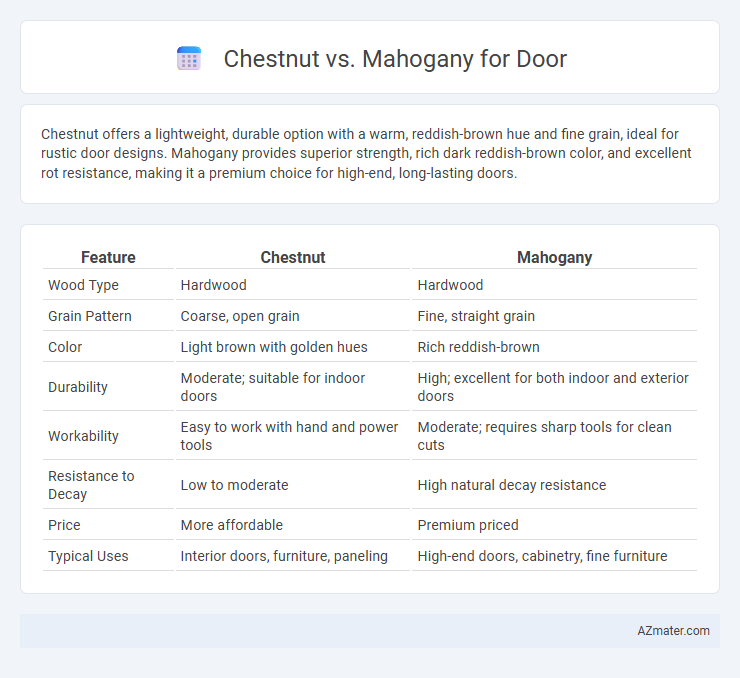Chestnut offers a lightweight, durable option with a warm, reddish-brown hue and fine grain, ideal for rustic door designs. Mahogany provides superior strength, rich dark reddish-brown color, and excellent rot resistance, making it a premium choice for high-end, long-lasting doors.
Table of Comparison
| Feature | Chestnut | Mahogany |
|---|---|---|
| Wood Type | Hardwood | Hardwood |
| Grain Pattern | Coarse, open grain | Fine, straight grain |
| Color | Light brown with golden hues | Rich reddish-brown |
| Durability | Moderate; suitable for indoor doors | High; excellent for both indoor and exterior doors |
| Workability | Easy to work with hand and power tools | Moderate; requires sharp tools for clean cuts |
| Resistance to Decay | Low to moderate | High natural decay resistance |
| Price | More affordable | Premium priced |
| Typical Uses | Interior doors, furniture, paneling | High-end doors, cabinetry, fine furniture |
Introduction to Chestnut and Mahogany for Doors
Chestnut doors provide a durable and affordable option, known for their warm tones and prominent grain patterns that enhance traditional and rustic interiors. Mahogany offers superior strength and rich, deep reddish-brown hues, making it a preferred choice for high-end doors requiring elegance and long-lasting durability. Both woods are prized for their natural resistance to decay, with mahogany typically commanding a higher price due to its density and refined finish quality.
Appearance and Color Variations
Chestnut doors exhibit a warm, rich brown hue with subtle reddish tones, offering a natural, rustic appeal and distinct grain patterns that highlight its organic texture. Mahogany doors are prized for their deep, reddish-brown color that can darken over time, providing a luxurious, elegant finish with a smooth, fine grain that enhances formal and classic interiors. Both woods present durable options, but chestnut offers more variation in color intensity, while mahogany maintains a consistent, polished appearance.
Grain Patterns and Texture
Chestnut doors feature a coarse, open grain with prominent streaks and a slightly rough texture, offering a rustic and natural appearance ideal for traditional or farmhouse styles. Mahogany doors display a fine, interlocked grain with a smooth, even texture that lends a luxurious, polished look often preferred in classic or formal interiors. The choice between chestnut and mahogany depends on desired aesthetic, with chestnut providing bold, textured grain patterns and mahogany delivering consistent, elegant refinement.
Durability and Strength Comparison
Chestnut wood offers moderate durability with decent resistance to wear and insect damage, making it suitable for interior doors in low to medium traffic areas. Mahogany is renowned for its exceptional strength and high durability, boasting natural resistance to decay and moisture, which makes it ideal for both interior and exterior door applications. When comparing the two, mahogany outperforms chestnut in terms of longevity and structural integrity under varying environmental conditions.
Weather Resistance and Longevity
Chestnut offers moderate weather resistance with natural oils that help withstand moisture, making it a reliable choice for doors in mild climates. Mahogany excels in longevity and weather resistance due to its dense grain and natural resistance to rot, decay, and insect damage, which enhances door durability in harsh weather conditions. For long-lasting exterior doors, mahogany typically outperforms chestnut by maintaining structural integrity and appearance over extended periods.
Workability and Ease of Installation
Chestnut wood offers excellent workability due to its straight grain and medium-density, making it easier to cut, shape, and sand for door construction. Mahogany is also prized for its smooth texture and stability, providing a straightforward installation process with less risk of warping or splitting. Both woods facilitate efficient craftsmanship, but chestnut's lighter weight enhances handling during installation.
Cost Differences and Value for Money
Chestnut doors generally cost less than mahogany doors due to the faster growth rate and greater availability of chestnut wood, making it a more budget-friendly option. Mahogany doors command a higher price because of their rich color, durability, and prestigious reputation, which enhances long-term value and curb appeal. Choosing chestnut offers good value for money with solid performance and aesthetic appeal, while mahogany provides superior longevity and elegance, justifying its premium cost for upscale properties.
Maintenance Requirements
Chestnut doors require moderate maintenance, including regular sealing and occasional sanding to prevent moisture damage and preserve their natural grain. Mahogany doors are more durable and resistant to rot and insects, needing less frequent refinishing, typically only every few years with a high-quality varnish. Both woods benefit from protective finishes, but mahogany's dense, oily nature makes it easier to maintain in harsh environments with less frequent upkeep.
Sustainability and Environmental Impact
Chestnut doors offer a sustainable choice due to their fast growth rate and lower environmental impact compared to mahogany, which is slower-growing and often harvested from tropical rainforests facing deforestation risks. Chestnut's carbon sequestration benefits and renewable availability make it an eco-friendly option for door manufacturing. Mahogany's extraction can contribute to habitat destruction and biodiversity loss, making responsible sourcing and certification essential for minimizing ecological footprint.
Best Uses and Design Applications
Chestnut offers durability and a warm, rustic appearance ideal for traditional and country-style doors, providing natural resistance to decay and insects. Mahogany is prized for its rich, deep reddish-brown color and fine grain, making it perfect for high-end, formal entryways that require elegance and a smooth finish. Both woods work well in exterior doors, but mahogany's superior density and stability make it better suited for intricate carvings and detailed design applications.

Infographic: Chestnut vs Mahogany for Door
 azmater.com
azmater.com